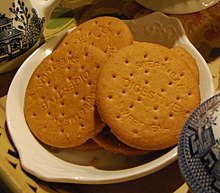Biskuit pancernaan
 | |
| Jeneng liyané | Wheaten, sweet-meal biscuit |
|---|---|
| Jinis | Biscuit |
| Panggonan asal | Scotland |
| Tlatah utawa praja | Forres |
| Woworan pokok | Wheat flour, sugar, malt extract, butter (or in cheaper recipes or for vegans or those who are lactose intolerant: vegetable oil), wholemeal, leavening agents (usually sodium bicarbonate, tartaric acid and malic acid), salt |
A biscuit pencernaan, kadhangkala dipratélakaké yèn biscuit manis-meal, punika semi manis biscuit sing asalé ing Skotlandia. Pencernaan pisanan dikembangake ing taun 1839 dening rong dhokter Skotlandia kanggo mbantu pencernaan. Tembung "pencernaan" asale saka kapercayan yen duwe sipat antacid amarga panggunaan natrium bikarbonat nalika pisanan dikembangake. [1] Historis, sawetara prodhusèn digunakake diastatic malt extract kanggo "Digest" sawetara saka pati sing urip ana ing glepung sadurunge baking . [2] [3]
Pisanan diproduksi ing taun 1892, pencernaan McVitie minangka biskuit laris ing Inggris. Ing taun 2009, pencernaan kasebut minangka biskuit kaping papat sing paling populer kanggo " dunking " dadi teh ing antarane masarakat Inggris, kanthi pencernaan coklat teka ing nomer siji. [4] Konsumsi biskuit ing Inggris iki minangka rekor: karo 6 yuta sing dikonsumsi saben dina, nuduhake 70 saben detik. [5]
[ <span title="This claim needs references to better sources. (September 2020)">luwih apik<span typeof="mw:Entity"> </span>sumber<span typeof="mw:Entity"> </span>dibutuhake</span> ]
Referensi
[besut | besut sumber]- ↑ "United Biscuits — McVitie's Brand History". Diarsip saka sing asli ing 15 February 2015.
- ↑ Chamber's encyclopaedia: a dictionary of universal knowledge, Volume 2. J.B. Lippencott Company. 1888. kc. 182. Dibukak ing 7 April 2011.
Digestive biscuits are prepared in such a manner that they may contain diastase, the nitrogenous transforming matter of malt; but whatever quantity of this substance they may contain in the condition of dough is destroyed in the process of baking.
- ↑ Pharmaceutical journal and Transactions. Third. Vol. XVII. London. 1887. kc. 156. Dibukak ing 8 April 2011.
A new competitor in this field was Paterson's Extract of Malt, exhibited by the Phoenix Chemical Works, Glasgow; the odour and flavour of this was excellent, and it is said to be rich in diastasic power. Prepared from it was exhibited a series of digestive biscuits, rusks and bread by John Montgomerie, of Glasgow. In making these part of the starch of the flour is changed by being mixed with the malt extract and water and kept for some time at a suitable temperature; the yeast being probably added to another portion of flour and water, to form dough to mix with the above before baking. These biscuits seemed to be appreciated by visitors. Messrs. Hill and Son also exhibited some malted nursery biscuits. Benger's well known digestive ferments were well displayed, together with an essence of rennet recently introduced.
- ↑ "Chocolate digestive is nation's favourite dunking biscuit". The Telegraph. 2 May 2009
- ↑ Made in Scotland, Carol Foreman
